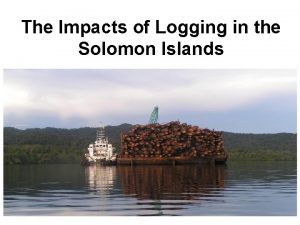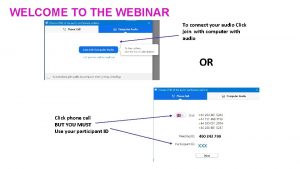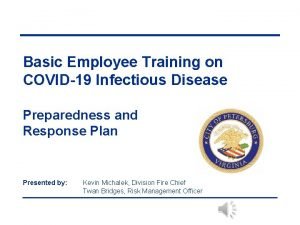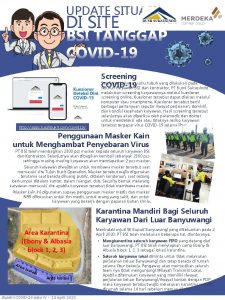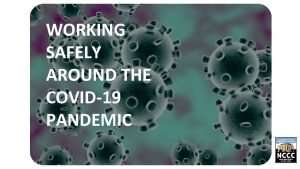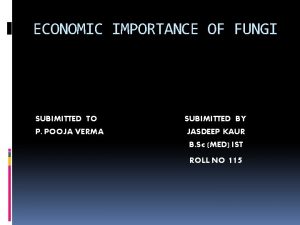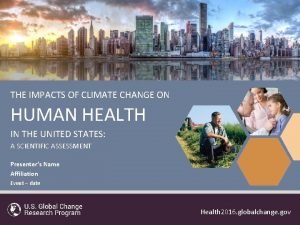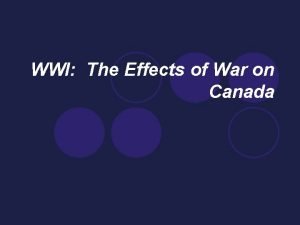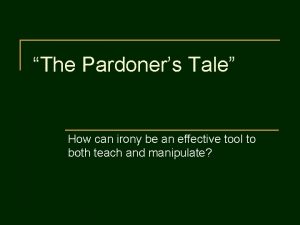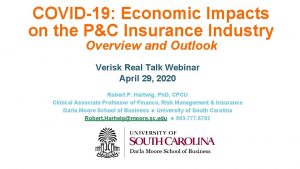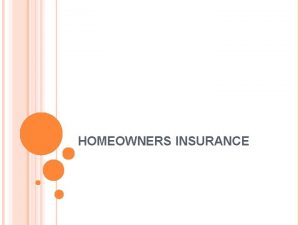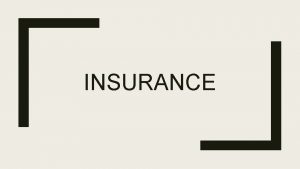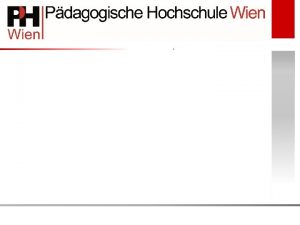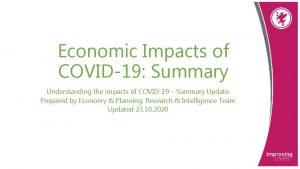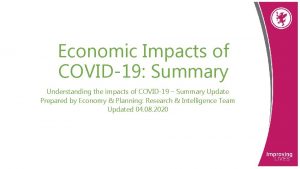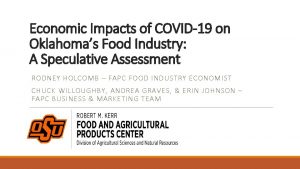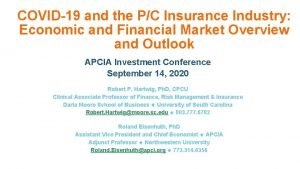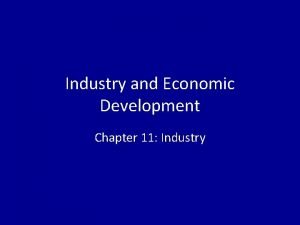COVID19 Economic Impacts on the PC Insurance Industry














- Slides: 14

COVID-19: Economic Impacts on the P&C Insurance Industry Overview and Outlook Gen Re Client Webinar April 23, 2020 Robert P. Hartwig, Ph. D, CPCU Clinical Associate Professor of Finance, Risk Management & Insurance Darla Moore School of Business University of South Carolina Robert. Hartwig@moore. sc. edu 803. 777. 6782

US Real GDP Growth* Real GDP Growth (%) “Great Recession” began in Dec. 2007 Financial Crisis COVID-19 pandemic is expected to result in 2 quarters of economic contraction before recovery later in the year Q 2 2020 GDP expected to shrink by 22. 3% Demand for Insurance Will Be Impacted As the Economy Slows but Should Improve by Late Q 3 and into Q 4 * Estimates/Forecasts from Wells Fargo Securities. Source: US Department of Commerce, Wells Fargo Securities 4/8/20; Center for Risk and Uncertainty Management, University of South Carolina.

The Economy Drives P/C Insurance Industry Premiums: 2006: Q 1– 2019: Q 3 Direct Premium Growth (All P/C Lines) vs. Nominal GDP: Quarterly Y-o-Y Pct. Change y-o-y nominal GDP growth DWP y-o-y change 8% 6% 4% 2% 0% As GDP growth turns negative in 2020, DWP will decelerate sharply and likely turn negative in some lines. Rebates, discounts and rate decreases will amplify the deceleration. -2% -4% -6% Sources: SNL Financial; U. S. Commerce Dept. , Bureau of Economic Analysis; ISO; I. I. I. ; Risk and Uncertainty Management Center, University of South Carolina. 2019: Q 3 2019: Q 1 2018: Q 3 2018: Q 1 2017: Q 3 2017: Q 1 2016: Q 3 2016: Q 1 2015: Q 3 2015: Q 1 2014: Q 3 2014: Q 1 2013: Q 3 2013: Q 1 2012: Q 3 2012: Q 1 2011: Q 3 2011: Q 1 2010: Q 3 2010: Q 1 2009: Q 3 2009: Q 1 2008: Q 3 2008: Q 1 Direct written premiums track nominal GDP fairly tightly over time, suggesting the P/C insurance industry’s growth prospects inextricably linked to economic performance.

Initial Claims for Unemployment: COVID Surge Shatters Records All the jobs created since the Great Recession have been lost —in just 5 weeks! (Thousands) Since mid-March a record 26. 46 million people have filed for unemployment Previous Records Week Ending Source: US Bureau of Labor Statistics; Risk and Uncertainty Management Center, University of South Carolina. Payroll exposures are taking a huge hit leading to a large impact on workers comp premiums written 4

US Unemployment Rate Forecast: 2007: Q 1– 2021: Q 4 Great Recession Rising unemployment eroded payrolls and WC’s exposure base. Unemployment peaked at 10% in late 2009. The unemployment rate will peak around 20% by June (15. 1% Q 2 avg. ) At 3. 5%, the unemployment rate in Feb. 2020 WAS at its lowest point in 50 years. = actual; = forecasts Sources: US Bureau of Labor Statistics; Wells Fargo Securities (4/20 edition); Risk and Uncertainty Management Center, University of South Carolina.

S&P 500 Index Returns, 1950– 2020* The S&P 500 was up 28. 9% in 2019, the best year since 2013, following a decline of 6. 2% in 2018. Gains are jeopardized by sharp declines amid COVID-19 pandemic Annual Return 2019: +28. 9% 2018: -6. 2% 2017: +19. 4 2016: +9. 5 Fed Raises Rates Energy Crisis Tech Bubble Implosion Financial Crisis , *Through April 15, 2020. Source: NYU Stern School of Business: http: //pages. stern. nyu. edu/~adamodar/New_Home_Page/datafile/histret. SP. html; Center for Risk and Uncertainty Management, University of South Carolina 2020 YTD -14. 8%

US Treasury Security Yields: A Long Downward Trend, 1990– 2020* Yields on 10 -Year US Treasury Notes have been essentially below 5% for more than a decade Fed emergency rate cuts and QE in response to the COVID-19 pandemic and market volatility have pushed rates to their lowest levels since the financial crisis 10 -YR. TREASURY 4/2019: 2. 53% 4/12/20: 0. 68% Since roughly 80% of P/C bond/cash investments are in 10 -year or shorter durations, most P/C insurer portfolios will have low-yielding bonds for years to come. *Monthly, constant maturity, nominal rates, through March 2020. Sources: Federal Reserve Bank at http: //www. federalreserve. gov/releases/h 15/data. htm. National Bureau of Economic Research (recession dates); Insurance Information Institute.

Profitability Peaks & Troughs in P/C Insurance Industry ROE, 1975 – 2019 E ROE 1977: 19. 0% 10 Ye ROEs in 2017 plunged to their lowest levels since 2008 but rebounded in 2018 due to lower CATs and the TCJA. 1987: 17. 3% 1997: 11. 6% ars 10 Ye ars 9 Years 2006: 12. 7% 2013 9. 8% 2017 5. 0% 1975: 2. 4% 1984: 1. 8% 1992: 4. 5% 2015: 8. 4% 2018 8. 0% 2019 E 8. 5% 2001: -1. 2% Profitability = P/C insurer ROEs. 2011 -18 figures are estimates based on ROAS data. Note: Data for 2008 -2014 exclude mortgage and financial guaranty insurers. Source: NAIC, ISO, A. M. Best, USC RUM Center.

Net Premium Growth (All P/C Lines): Annual Change, 1971— 2019 F (Percent) 2019 F: 3. 0% 2018 E: 10. 8% 1975 -78 1984 -87 2000 -03 2017: 4. 6% 2016: 2. 7% Net Written Premiums Fell 0. 7% in 2007 (First Decline Since 1943) by 2. 0% in 2008, and 4. 2% in 2009, the First 3 Year Decline Since 1930 -33. 2015: 3. 5% 2014: 4. 2 2013: 4. 4% 2012: +4. 2% Outlook 2019 F: 3. 0% 2020 F: 3. 8% *Figure is actual 2018: 9 M vs. 2017: 9 M change adjusted for affects of the TCJA of 2017. Shaded areas denote “hard market” periods Sources: A. M. Best (1971 -2013, 2020 F), ISO (2014 -19); Risk & Uncertainty Management Center, Univ. of South Carolina estimate for 2019. 9

Policyholder Surplus (Capacity), 2006: Q 4– 2019: Q 3 The P/C insurance industry entered the COVID-19 pandemic from a position strength ($ Billions) Drop due to near-record 2011 CAT losses Financial Crisis 2010: Q 1 data includes $22. 5 B of paid-in capital from a holding company parent for one insurer’s investment in a noninsurance business. Sources: ISO, A. M. Best; 2019 E from Center for Risk and Uncertainty Management, University of South Carolina, based on actual $812. 2 B through 9/30/2019. Policyholder Surplus is the industry’s financial cushion against large insured events, periods of economic stress and financial market volatility. It is also a source of capital to underwrite new risks. 10

Estimated Monthly U. S. Business Interruption Coronavirus Losses for Small Business—Potential Range (<100 Employees; $Bill) $500 $400 The potential for such losses for all businesses of all sizes is currently estimated at $1 - $1. 1 trillion per month. Monthly BI losses for small business vary widely depending on underlying assumptions but expansive legislation would result in higher estimates $223 $300 $431 $255 $200 $100 $52 $0 Small Business w/ BI - Low 60% Businesses impacted* 10% of Payroll for additional expenses 33. 3% Have BI coverage 50% Have BI payroll/benefits coverage Small Business w/ BI - High 90% Businesses impacted* 30% of Payroll for additional expenses 60% Have BI coverage 80% Have BI payroll/benefits coverage All Small Businesses - Low 60% Businesses Impacted* 10% of Payroll for additional expenses * Businesses impacted: Proportion of businesses completely or substantially closed related to coronavirus Assumptions: Losses if standard insurance policy exclusions for viruses/pandemics are voided and physical loss/damage requirement is stricken; three main coverages - profit lost, payroll/benefits, additional expenses; average annual $2 m revenue and 7% profit margin; non-wage benefits of small businesses are 25% less than that for Source: APCIA, April 2020. All Small Businesses - High 90% Businesses impacted* 30% of Payroll for additional expenses Legislation in several states would trample over contracts and destroy the state’s insurance markets

Workers Compensation Combined Ratio: 1994– 2019 P WC results have improved markedly since 2011. The 2018/19 combined ratios were the best in at least 80 years. COVID 19 will put upward pressure on results Workers Comp’s Record Underwriting Performance Will Come to an Abrupt in End in 2020 as COVID-19 Claims (including Presumptions) Take Their Toll Sources: A. M. Best (1994 -2009); NCCI (2010 -2018) and are for private carriers only. . 12

Personal Auto and Commercial Auto: Much Depends on the Pace of Recovery, Total Magnitude of Rebates Outlook: Small business sentiment will continue to fall sharply with significant negative repercussions for p/c insurers Source: Assured Research, 4/20/20. . There is much uncertainty related to the pace of recovery, which will directly influence claim frequency The economic fallout from COVID-19 will cause small business sentiment to plunge causing hiring and investment to move sharply negative

Thank you for your time and your attention! Twitter: twitter. com/bob_hartwig For a copy of this presentation, email me at robert. hartwig@moore. sc. edu or Download at www. uscriskcenter. com 14
 Economic impacts of logging in solomon islands
Economic impacts of logging in solomon islands Covid19 athome rapid what know
Covid19 athome rapid what know What do if test positive covid19
What do if test positive covid19 Http//apps.tujuhbukit.com/covid19
Http//apps.tujuhbukit.com/covid19 Vaksin covid19
Vaksin covid19 Do if you covid19
Do if you covid19 Nature of fire insurance
Nature of fire insurance Economic importance of fungi
Economic importance of fungi Chapter 1 lesson 2 our economic choices worksheet answers
Chapter 1 lesson 2 our economic choices worksheet answers Economic growth vs economic development
Economic growth vs economic development Difference between economic growth and economic development
Difference between economic growth and economic development Impacts of climate change
Impacts of climate change Negative impacts of war
Negative impacts of war The pardoner's tale irony examples
The pardoner's tale irony examples Luqman long
Luqman long
